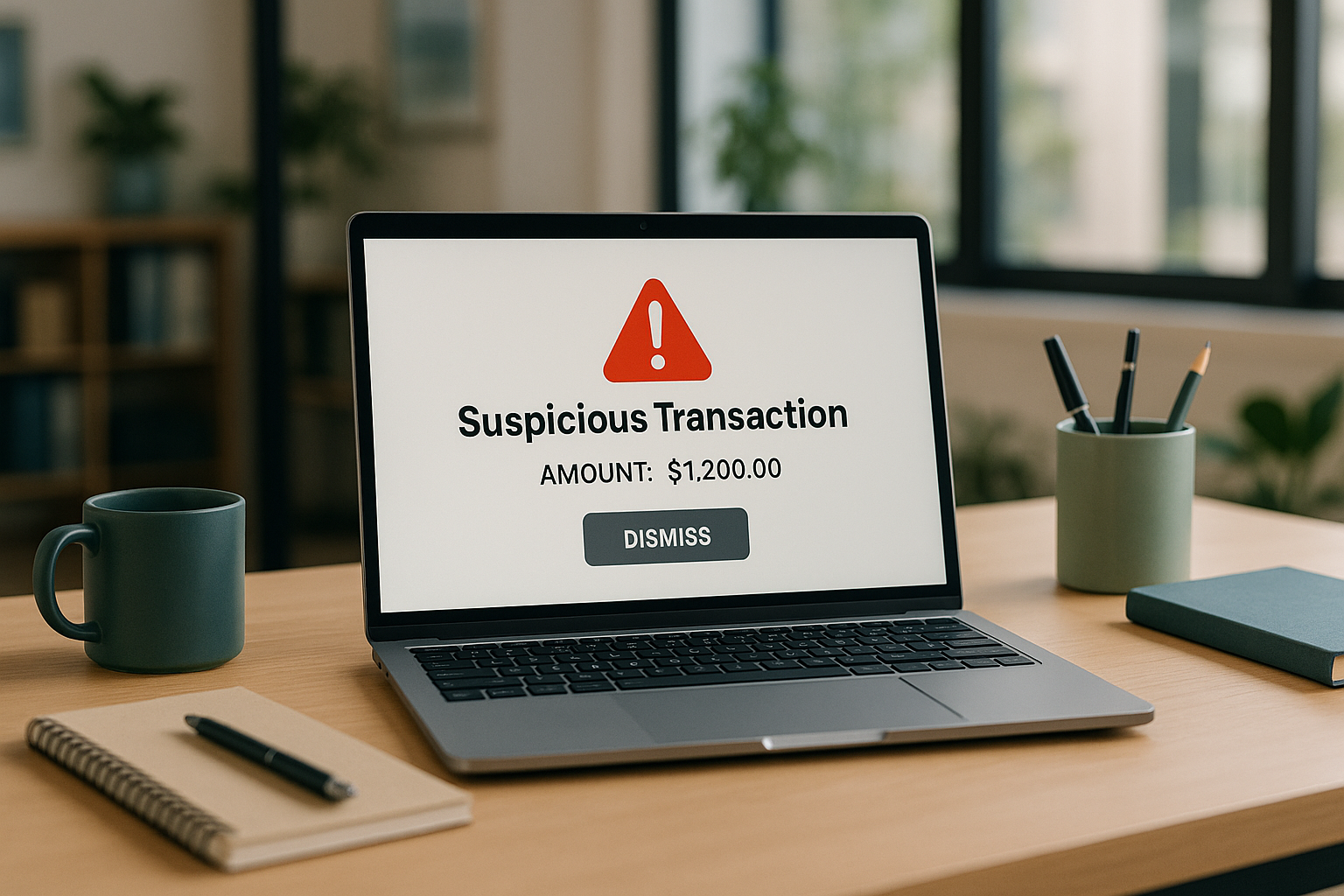Merchant account fraud is costing businesses billions every year. Fraudsters use tactics like bust-out scams, transaction laundering, and micro-transaction testing to exploit payment systems. In 2023 alone, merchants lost $20 billion to chargeback fraud, and this number is expected to hit $28.1 billion by 2026. Here’s what you need to know to protect your business:
- Watch for red flags: Sudden sales surges, mismatched customer details, and location inconsistencies are common signs of fraud.
- Monitor chargebacks: Frequent disputes, especially from the same customer, can indicate chargeback abuse or friendly fraud.
- Invest in prevention tools: Use AI-powered fraud detection, geolocation tools, and multi-factor authentication to reduce risks.
With fraud attempts rising by 9% monthly, staying vigilant and using advanced tools is critical to safeguarding your payment systems.
Different types of merchant account fraud
Common Transaction Red Flags
Spotting unusual transaction patterns is key to identifying potential merchant fraud. With card-not-present fraud accounting for a staggering 74% of all payment card fraud in 2024 [2], being vigilant about these warning signs can help safeguard your business. Let’s break down some of the most common red flags and how to address them.
Unexpected Transaction Volume Changes
Keep an eye out for:
- Sudden sales surges in specific regions, which can indicate suspicious activity [3].
- Transactions that exceed normal ticket sizes, as these may require further investigation.
- Multiple even-dollar transactions (e.g., $100.00) that could signal automated fraud attempts [3].
"Merchant fraud can often be detected by some kind of untypical behavior of the merchant. Deviations from historical averages of processed transaction volumes, abrupt change in processing patterns, untypical processing hours and entry modes, large numbers of even-amount transactions, long-term inactivity of the account – these are the criteria, signifying potential fraud."
- James Davis, Senior Technical Writer at United Thinkers [3]
Micro-Transaction Testing
Fraudsters often test stolen cards with small transactions before attempting larger purchases. Warning signs include:
- Numerous small charges from the same account.
- A pattern of failed high-value transactions followed by successful low-value ones [2].
- Repeated attempts using different expiration dates.
To combat this, consider implementing velocity limits and real-time monitoring tools designed to detect micro-transaction patterns. Accounts exhibiting this behavior should be flagged immediately, especially if larger purchase attempts follow.
Location Mismatch Warnings
Geographic inconsistencies can be a major giveaway for fraudulent activity. Modern geolocation tools can pinpoint locations with 95-99% accuracy at the country level [4]. Here’s what to watch for:
| Location Check | Risk Indicator |
|---|---|
| IP Address vs. Billing | Discrepancies between countries or regions |
| Shipping vs. Billing | Multiple addresses linked to the same account |
| Login Location | Sudden changes or logins from multiple locations |
| High-Risk Regions | Orders from areas known for elevated fraud rates |
"Geolocation is central to modern fraud detection across a number of industries. Understanding any sort of anomalous geolocation data coming from a particular device or inconsistent location data across devices for the same account can help detect fraud and stop bad actors."
Orders originating from high-risk regions should raise immediate red flags. For example, transactions from Latin America and the Asia-Pacific are 60% more likely to be fraudulent compared to those from the U.S. [2]. To mitigate risks, use address verification services (AVS) and require additional authentication for orders with mismatched location data.
Warning Signs in Customer Actions
While transaction patterns are a major clue, a deeper dive into customer data and behavior can also reveal potential fraud.
Mismatched Customer Data
Inconsistent customer information often raises suspicions. In fact, a 2023 study showed that 80% of businesses experienced payment fraud attacks, with mismatched customer details being a common red flag [2].
| Data Point | Warning Signs |
|---|---|
| Address Information | Multiple shipping addresses tied to one card, use of freight forwarders, or P.O. boxes |
| Personal Details | Unverifiable information, frequent typos, or details entered in ALL CAPS |
| Location Data | IP address that doesn’t match the billing or shipping location |
| Order History | Repeated failed transactions under the same profile |
Here’s a real-world example: In March 2025, an electronics retailer flagged multiple orders headed to the same Bronx address but linked to different credit cards. Upon investigation, they discovered a freight forwarding service being used to ship stolen goods overseas. By tightening their verification process, they managed to block $50,000 worth of fraudulent transactions [2].
Customer behavior can be just as telling when it comes to spotting fraud.
High-Risk Customer Behavior
Rushed Transactions
- Quick purchases with little hesitation
- Requests for immediate shipping upgrades
- Minimal or no questions about the product
Shipping Concerns
- Obsessive focus on shipping updates
- Frequent changes to shipping destinations
- Lack of interest in shipping details, even for expensive items
Payment Patterns
- Multiple failed payment attempts with slight variations in card details
- Rapid, identical orders processed with different payment methods
- Bulk purchases of the same item in different sizes
Take, for example, a fraud ring uncovered in the fall of 2022. They used tactics like manipulating shipping addresses and managed to steal an estimated $660 million in goods by November of that year [6].
These behavioral cues, when combined with transaction and chargeback patterns, can create a well-rounded fraud detection system. To stay ahead, implement strong verification processes and keep detailed records of customer interactions to catch fraud before it escalates.
sbb-itb-8c45743
Chargeback Warning Signs
Spotting chargeback warning signs is a critical part of any fraud prevention strategy. With chargebacks rising by 20% each year, businesses face billions in losses annually [7].
Non-Delivery Dispute Increases
Certain patterns can signal non-delivery disputes:
- Frequent non-delivery chargebacks from the same customer
- Chargebacks filed before the expected delivery date
- Discrepancies in delivery confirmation records
Keeping detailed delivery documentation is essential to challenge these claims. According to Mastercard‘s 2021 report, there were 615 million chargebacks globally, contributing to an estimated $117 billion in merchant losses by 2023 [13].
Customer Chargeback Abuse
After addressing non-delivery issues, it’s important to identify signs of chargeback abuse. Friendly fraud alone accounts for 75% of disputes, leading to over $25 billion in losses annually [9]. Each chargeback can cost merchants 2 to 2.5 times the original transaction amount [10].
Common red flags include:
- Multiple chargebacks from the same customer in a short timeframe
- Disputes filed immediately after purchase
- Customers refusing to engage in communication with the merchant
- Different reasons cited for multiple chargebacks
"Friendly fraud happens when a cardholder uses the chargeback process incorrectly, either as an intentional attempt to get something for free or an innocent misunderstanding." – Jessica Velasco, Content Manager for Marketing [11]
Friendly fraud continues to rise, increasing by about 41% every two years, and now makes up 60-80% of all disputes [12].
How to Reduce Chargeback Abuse:
- Keep thorough records of all customer interactions
- Save proof of delivery for every order
- Track customers’ dispute histories
- Implement 3-D Secure authentication for higher-risk transactions
A recent study found that 72% of merchants have seen an uptick in friendly fraud attacks over the past three years [8].
Fraud Prevention Tools
With fraud losses hitting a staggering $41 billion in 2022 [15], businesses are increasingly turning to technology to protect themselves. Modern tools are designed not just to detect fraud but to anticipate and prevent it, making them critical for staying ahead of sophisticated threats.
Machine Learning Fraud Detection
AI-powered systems are transforming fraud detection by analyzing transactions in real-time with impressive accuracy – up to 96% in reducing e-commerce fraud [16]. These systems sift through vast amounts of data to identify even the most subtle fraud patterns.
The U.S. Treasury Department showcased the power of machine learning (ML) by saving an estimated $4 billion in 2024 through advancements in fraud detection [14]. Their system focused on:
- Real-time transaction risk scoring to flag suspicious activity instantly.
- Pattern recognition across massive datasets to identify recurring fraud tactics.
- Behavioral analysis to detect unusual customer actions.
- Automated detection that minimizes human oversight for routine checks.
"AI functions best as a companion to data analysts. By automating routine roles such as anomaly detection, it frees human specialists from the drudgery of nonstop monitoring. It also allows fraud experts to tackle more complex tasks that involve judgment and manual review." – Chargebacks911 [14]
Despite its proven effectiveness, only 23% of merchants currently use AI for fraud detection [14]. This gap highlights the potential for broader adoption, especially when paired with advanced identity verification measures.
Advanced Identity Verification
While AI systems excel at spotting anomalies, confirming the legitimacy of each transaction requires robust identity verification. In fact, 85% of consumers report feeling more secure when brands use advanced verification methods [18].
Core components of modern identity verification include:
- Biometric authentication for unique, secure identification.
- Device intelligence to track and assess the devices used in transactions.
- Multi-factor authentication for an added layer of security.
- Instant risk scoring to evaluate the likelihood of fraudulent activity.
One federal benefits program demonstrated the impact of automation by overhauling its re-verification process. The result? Savings of over $40 million and 1.3 million person-hours [17].
"Without effective processes, agencies face high costs from manual checks and risk undermining public trust." – Stuart Levy, Vice President of Public Sector Identity, TransUnion [17]
Fraud Data Networks
Fraud attempts are on the rise, with mid to large retailers seeing a 45% increase in successful monthly attacks [1]. Beyond individual tools, shared intelligence through fraud data networks strengthens defenses across the board.
Secured Payments enables businesses to tap into these networks, offering benefits like:
- Real-time fraud pattern sharing to alert merchants instantly.
- Cross-merchant fraud alerts to stop fraudsters from hopping between businesses.
- Industry-wide threat monitoring for a broader view of emerging risks.
- Collaborative defense strategies that unify efforts against fraud.
Conclusion: Next Steps for Fraud Protection
Merchant account fraud is taking a massive toll on U.S. businesses, costing them $48 billion every year [19]. With fraudsters becoming more sophisticated, businesses must adopt a strong, multi-layered defense to stay ahead.
The best fraud prevention strategies blend cutting-edge technology with well-trained teams capable of spotting fraud indicators [21]. A staggering 96% of U.S. companies reported experiencing a fraud attempt in the past year [24]. And while traditional measures play a vital role, they’re now facing new challenges from rapidly advancing AI-driven threats.
AI-assisted fraud has escalated significantly, with deepfake attacks skyrocketing by 3,000% between 2022 and 2023 [23]. To counter these threats, businesses should focus on:
- Real-time transaction monitoring enhanced with fraud scoring.
- Strong authentication methods, including biometrics and multi-factor verification.
- Frequent updates to security protocols and payment systems.
- Pattern monitoring to detect unusual or suspicious activity.
"No single factor can prevent card testing fraud, however, a multilayered approach can help merchants prevent card testing fraud attacks." – Una Ryan Kearns, Vice President of Fraud, J.P. Morgan [20]
The emergence of "Fraud-as-a-Service" and advanced AI tools has rendered traditional security measures inadequate [23]. Synthetic identity fraud alone is projected to cost U.S. businesses an eye-watering $23 billion annually by 2030 [22].
This means businesses must act now. Enhance your fraud detection systems, train your team to recognize evolving threats, and collaborate with a payment processor that understands your specific risks. Look for partners who utilize tools like machine learning for fraud detection and advanced verification to provide the protection you need.
Secured Payments offers tailored fraud prevention solutions designed to safeguard your business. By combining advanced technology with deep industry knowledge, they help protect your merchant account from today’s ever-evolving threats.
FAQs
What are the best ways to prevent merchant account fraud?
Preventing fraud in merchant accounts calls for a hands-on approach to security. One key step is using advanced fraud detection tools to keep an eye on transactions for anything out of the ordinary, like sudden increases in chargebacks or risky purchases. These tools can spot suspicious activity early, helping to minimize potential losses.
Another solid strategy is implementing multi-factor authentication (MFA). By requiring users – whether customers or employees – to verify their identity through multiple methods, you add an extra layer of security that makes unauthorized access much harder. On top of that, regularly reviewing account activity and training your team to spot red flags, such as mismatched customer details, can go a long way in protecting your business.
Lastly, make sure your business complies with Payment Card Industry Data Security Standards (PCI DSS) to secure sensitive payment information. Sticking to these practices not only lowers the risk of fraud but also strengthens customer confidence, ensuring transactions remain safe and dependable.
What is micro-transaction testing, and how can businesses detect and prevent it?
Micro-transaction testing happens when fraudsters use stolen payment details to make small, low-value purchases – often in round dollar amounts – to check if the payment information works. Spotting this type of fraud means keeping an eye out for unusual activity, like a sudden increase in small transactions or multiple attempts involving tiny amounts.
To combat this, businesses can use fraud detection tools that flag anomalies or track transaction velocity. Reviewing transaction data regularly for anything unusual and setting up pre-transaction measures, like payment limits or CAPTCHA challenges, can also add a layer of protection. On top of that, training staff to identify suspicious behavior and performing regular risk assessments are key to keeping your merchant account secure.
Why is it important to track location inconsistencies in transactions, and how can geolocation tools help prevent fraud?
Tracking location inconsistencies in transactions plays a crucial role in spotting potential fraud, like unauthorized account access or identity theft. By using geolocation tools, businesses can monitor where transactions occur and identify unusual patterns, such as logins or purchases from far-off or unexpected locations.
For example, if someone accesses a customer’s account from a location hundreds of miles away from their usual area – and within a timeframe that doesn’t make sense – it could be a red flag for fraudulent behavior. In such cases, these tools can activate extra security steps, like multi-factor authentication, to confirm the transaction and help shield your business from financial losses.




